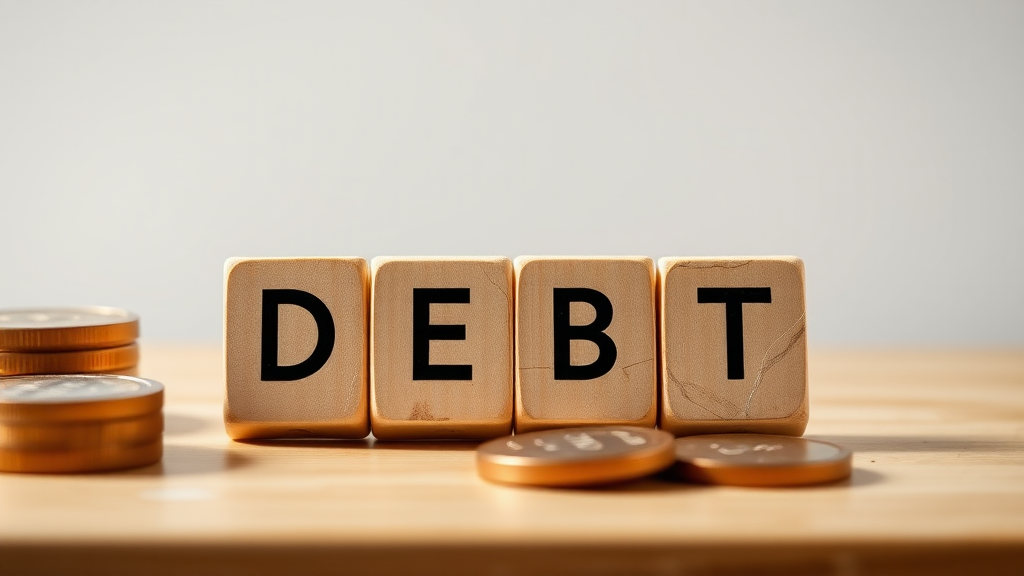Line of Credit Debt
Understand This Debt Type Today
line of credit debt, debt type
Understanding line of credit debt in Canada is crucial as it’s a significant debt type. Canadians often accrue this debt due to lifestyle choices and external factors like interest rates. Budgeting and consolidation can help manage it. Future trends suggest continued growth, so wise planning is essential.

Article: line of credit debt
Understanding Line of Credit Debt in Canada
Definition and types of line of credit available in Canada., Current trends and statistics on average line of credit debt among Canadians., Comparison of line of credit debt with other debt categories.
Understanding the ins and outs of line of credit debt in Canada is crucial, especially when you're trying to make smart financial decisions. A line of credit is a versatile loan arrangement where you can borrow up to a predetermined limit without needing a specific reason. Canadians have several options, including secured lines of credit, which are usually backed by assets like your house, offering lower interest rates and higher limits. On the flip side, unsecured lines and personal lines might come with higher interest but give you more flexibility without the need for collateral. There's also the Home Equity Line of Credit (HELOC) for homeowners looking to capitalize on their property's value. If you're a student, you might explore a student line of credit, offering tailored interest terms while you complete your studies.
When we take a closer look at current trends, it’s clear that the reliance on lines of credit is growing, with Canadians increasingly using them to manage day-to-day finances. Recent statistics indicate a rise in the average line of credit debt, sitting around several thousand dollars. Interestingly, among the available lines, HELOCs tend to see more utilization given their lower rates. The tensions around fluctuating interest rates by the Bank of Canada add an extra layer of complexity—making it prudent for borrowers to stay aware of economic trends that could affect their repayment landscape. The trends underscore the importance of prudent borrowing and repayment strategies to avoid potential pitfalls like rising debt levels.
Comparing line of credit debt with other debt categories like credit card balances or personal loans, lines of credit generally offer more favorable terms thanks to lower interest rates and flexibility in repayment. However, there’s a caveat: only paying the interest portion prolongs the debt, unlike fixed loan repayments which steadily reduce your principal debt. Lines of credit can be a smart option when looking to consolidate high-interest debts, like those pesky credit card bills. For instance, if you have multiple credit cards with interest rates north of 19%, transferring that to a line of credit could mean significant savings and simpler debt management. Always keep an eye on how you manage these funds—it’s about balancing benefits, risks, and ensuring that your debt ecosystem doesn’t spiral out of control.
Factors Contributing to Line of Credit Debt
Common reasons why Canadians accumulate line of credit debt., Role of economic factors, such as interest rates and inflation, on line of credit debt levels., Impact of personal financial habits and unexpected economic events on borrowing behaviors.
Many Canadians find themselves accumulating line of credit debt due to a mix of lifestyle choices and financial necessities. For instance, a personal line of credit might seem like a lifesaver when dealing with unexpected expenses, like a car repair or medical bill. But overreliance can quickly lead to accumulating debt, especially if repayments are only covering the interest. Additionally, many use lines of credit for home renovations or consolidating high-interest debt, which, while beneficial at first, can spiral out of control if not managed wisely. The allure of low interest rates compared to credit cards is tempting, but it requires disciplined financial habits to prevent it from becoming a financial pitfall.
The economic environment in Canada significantly influences line of credit debt levels. When interest rates are low, borrowing becomes more attractive, encouraging Canadians to tap into their credit lines more freely. However, when the Bank of Canada decides to increase these rates to curb inflation, borrowers may find themselves paying more in interest than they originally anticipated. This can lead to financial distress, especially if they’ve maxed out their credit limits. Inflation plays a silent yet impactful role, too. As the cost of living rises, consumers might rely more on borrowed money to maintain their lifestyle, unintentionally increasing their debt burden.
Personal financial habits and unforeseen economic events can dramatically alter borrowing behaviors. For example, a disciplined borrower who typically pays more than the interest might revert to minimum payments during job loss or economic downturns, inadvertently extending their debt duration. Conversely, positive financial habits, like budgeting or setting automatic payments toward the principal, can mitigate these risks. Events like the COVID-19 pandemic have shown how sudden economic disruptions push many Canadians to rely on lines of credit for essentials, highlighting the need for robust financial planning. Whether navigating interest rate hikes or unexpected life events, being proactive rather than reactive is key to managing line of credit debt effectively.
Elimiate up to 80% of Your Debt
High cost of gas, high cost of groceries, high lending rates, low salary - being in debt is not your fault! See if you qualify for government debt programs and get out of debt today!
Strategies for Managing Line of Credit Debt
Practical steps for creating a repayment plan for line of credit debt., The importance of budgeting and financial planning in debt management., Exploring consolidation options and their potential impacts on line of credit debt.
Budgeting and financial planning play a critical role in navigating line of credit debt in Canada. Think of your budget as a roadmap for your finances—without one, it's easy to get lost in the sea of debt. Start by assessing your monthly expenses and income, identifying areas where you can cut back and funnel more towards your debt repayment. Suppose you usually spend $200 a month on dining out. Reducing this to $100 could free up extra funds for paying down your line of credit. Tracking every dollar ensures you're not exceeding your limits and helps you stay focused on your financial goals.
Creating a practical repayment plan for line of credit debt involves setting SMART goals—Specific, Measurable, Achievable, Relevant, and Time-bound. Begin by calculating your total debt and setting a realistic timeline for repayment. Consider the interest rates, which are often variable and linked to the lender’s prime rate, meaning they can fluctuate. Making more than the minimum payment is essential; even a small increase can significantly reduce your total interest paid over time. Let’s say your minimum payment is $50. Boosting it to $100 could shorten your repayment period and lessen financial stress.
Exploring consolidation options is another strategy worth considering. Consolidating your debts into a single loan with a lower interest rate can streamline payments and potentially save money on interest. For example, using a home equity line of credit (HELOC) to consolidate credit card debt could harness lower interest rates. But tread carefully—securing debt with your home means defaulting could risk your property. Each option comes with its pros and cons, so weigh them according to your specific situation. Always consult with a financial advisor to ensure that the solution aligns with your financial goals and circumstances.

Understanding line of credit debt as a debt type.
Expert Opinions on Line of Credit Debt Management
Insights from financial experts on managing and reducing line of credit debt., Case studies illustrating successful line of credit debt management strategies., Innovative financial products and services aiding in debt management.
Managing line of credit debt in Canada can sometimes feel like trying to tame a wild bear, but thankfully, financial experts have plenty of advice on how to keep it under control. A popular strategy involves maintaining a strict budgeting plan that prioritizes both paying off the interest and gradually chipping away at the principal amount. Experts often recommend consolidating higher-interest debts with lines of credit, as these tend to offer lower interest rates. Imagine using a line of credit like a well-trained dog pulling your sled—efficiently speeding up your financial journey rather than dragging you back.
Take Jane from Vancouver, for example. Staring down an unmanageable line of credit, Jane turned her financial situation around by focusing on a disciplined repayment schedule. She diligently avoided only making minimum payments, which would have barely nibbled at the interest. Instead, she redirected funds from non-essential spending to increase her principal payments. Within two years, Jane managed to reduce her debt significantly, demonstrating that strategic planning and financial education can transform looming debt into manageable chunks.
In terms of innovative financial products and services, various platforms offer tools specifically designed to aid in debt management. These include apps that help track spending and alert you when you’re approaching your credit limit, as well as programs that automatically allocate a portion of your income towards debt repayment. Think of it as having a personal trainer—except one focused on pumping up your finances. Such resources empower individuals to make informed decisions, with the added benefit of changing daunting financial responsibilities into aspirational, achievable goals.
Future Outlook and Recommendations
Forecast on the future trends of line of credit debt in Canada., Government policies and regulatory changes impacting line of credit products., Recommendations for consumers and financial institutions to mitigate the risk of growing line of credit debt.
The future trends of line of credit debt in Canada are poised to reflect both challenges and opportunities. With variable interest rates tied to the Bank of Canada’s prime rate, fluctuations in economic conditions can significantly impact borrowers. In recent years, we've seen a shift towards using lines of credit for consolidating debt, which, while practical, makes individuals vulnerable to rising rates. For instance, if you're using a home equity line of credit (HELOC) that's currently affordable, an increase in the prime rate could lead to financial strain. That's why it's crucial to stay informed about economic forecasts and have a backup plan if rates increase.
Government policies and regulatory changes are playing an essential role in reshaping the landscape of line of credit products. Recent initiatives aimed at tightening lending standards are designed to mitigate financial risks for consumers. For instance, regulations now demand more rigorous assessments of borrowers’ ability to handle debt, reducing the chances of over-lending. Moreover, there’s an increasing push towards enhancing transparency, ensuring borrowers fully understand terms before committing. These changes help protect consumers but also require borrowers to be more diligent in maintaining good credit standing to access competitive credit products.
To mitigate the risk of growing line of credit debt, both consumers and financial institutions should adopt proactive strategies. For consumers, it’s about budgeting wisely and setting limits on borrowing. Aim to borrow only what is necessary and ensure that any existing debts are manageable even if conditions change. On the other hand, financial institutions should offer more educational resources to help consumers understand repayment structures and interest rate impacts. By promoting financial literacy and responsible borrowing, both parties can reduce the chances of encountering unmanageable debt levels in the future. For example, some banks now provide online tools that simulate changes in payments with varying interest rates, arming consumers with the knowledge needed for better financial planning.
References
| Title, Source |
|---|
| 2022 Canadian Household Debt Report, Equifax Canada |
| Bank of Canada Financial System Review, Bank of Canada |
| Consumer Debt in Canada: Borrowing Trends and Employment Correlates, Statistics Canada |
| Managing Credit: Practical Strategies for Canadians, Financial Consumer Agency of Canada |
| Personal Finance and Debt Strategies, Ontario Securities Commission |
This article references information from the above sources.
Eliminate up to 80% of Your Debt
High cost of gas, high cost of groceries, high lending rates, low salary - being in debt is not your fault! See if you qualify for government debt programs and get out of debt today!